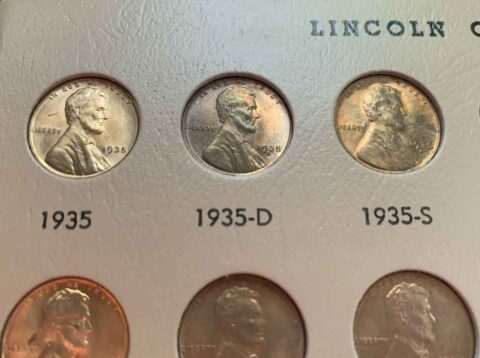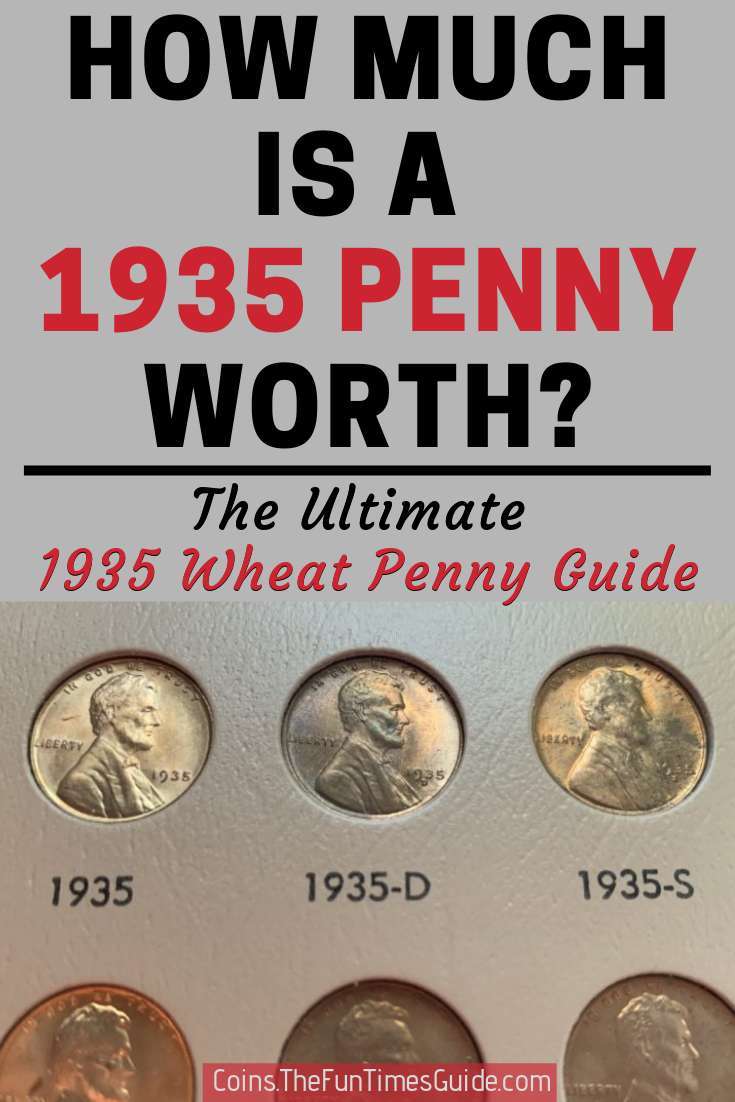Want to know if your 1935 penny is worth more than face value?
I’ll tell you right off the bat that your 1935 wheat penny is worth more than just one cent!

But… how much more?
There are many factors that affect the value of a 1935 wheat penny:
- Where it was minted (“S”, “D”, or no mintmark)
- Whether it’s been used as money or not (circulated vs. uncirculated)
- The condition of the coin (a.k.a. coin grade)
- And whether or not it has any errors or varieties (see list below)
Now, let’s see how much your 1935 penny is worth…
How Much Is A 1935 Penny Worth?
Virtually all 1935 pennies are worth more than face value for these reasons:
- They’re obsolete, bearing designs that have not been struck in decades
- They are growing scarcer as time goes on
- They contain copper, which has become increasingly valuable in recent years
At the very least, 1935 Lincoln cents are worth 2 cents for their copper value alone — but most are worth 3 to 5 cents or more.
Here are the details:
1) 1935 Penny Value (No Mintmark)
The Philadelphia-minted 1935 Lincoln cent with no mintmark is a very common coin that saw a huge mintage of 245,388,000. Not all of these coins survive today — but many are still around.
- A well-circulated specimen is worth between 3 and 10 cents.
- Uncirculated examples (the kind never used as money) have a value of about $5 and up.
The most valuable 1935 Lincoln penny was graded by Professional Coin Grading Service (PCGS) as MS-68+ Red and approved for superior quality by Certified Acceptance Corporation (CAC). It sold for $34,075 in 2018!
2) 1935-D Penny (“D” Mintmark)
While 1935-D Lincoln cents made at the Denver Mint were struck in much smaller numbers than the Philly-minted 1935 pennies, they’re still pretty common.
A total of 47,000,000 were struck carrying a little “D” mintmark on the obverse (heads side) under the date.
- Moderately to heavily worn pieces are worth 5 to 15 cents.
- Uncirculated specimens are worth around $6 to $8 and up.
In 2018, the price record for a 1935-D Lincoln cent was made when one example graded by PCGS as MS-67+ Red and approved by CAC sold for $4,080!
3) 1935-S Penny (“S” Mintmark)
Scarcest of all 1935 pennies is the 1935-S from the San Francisco Mint.
The 1935-S Lincoln cents saw a mintage of 38,702,000. So, while that is much lower than even its Denver-minted counterpart, it’s still common enough to be found with some frequency. I’ve even found one in pocket change!
- A 1935-S penny is worth approximately 10 to 25 cents for a well-worn specimen.
- An uncirculated example begins at around $7 to $10.
Among the most valuable 1935-S Lincoln cents is an MS-67 Red certified by PCGS that sold for $23,000!
IMPORTANT: What Is The Grade Of Your 1935 Penny?
To determine the true value of your 1935 wheat penny, you first need to know what condition (or grade) your coin is in.
Grab a coin magnifier and a copy of the U.S. Coin Grading Standards book. Then, watch this video to see how to grade coins yourself at home:
These coin grading apps make grading coins yourself SO much easier!
A List Of Rare 1935 Penny Errors To Look For
So… pretty much all 1935 wheat pennies are worthy of holding on to since they’re all worth more than face value.
But which ones are the really rare coins that carry a significant premium over face value?
Well, except for the uncirculated examples (which you can’t find in pocket change), there are a lot of 1935 penny errors and varieties that you can find if you know what you’re looking for.
Here are the most popular 1935 penny errors and varieties to look for:
1935 Doubled Die Pennies
Doubled dies are a type of error that occurs when the hub impresses a design on the die (the mechanism that stamps blank coins, or planchets) at two slightly different and distinct angles. Some of the most popular doubled die coins include the 1955 doubled die penny and 1969-S doubled die penny.
There are a few attributed doubled dies known to exist among each of the three 1935 penny issues:
- 1935 doubled die penny — Some of the 1935 Philly Lincoln cent doubled dies show marked doubling in the obverse inscriptions and in Lincoln’s eye.
- 1935-D doubled die penny — One of the most drastic of the 1935-D doubled die cents exhibits doubling in E PLURIBUS UNUM on the reverse.
- 1935-S doubled die penny — At least one example of the 1935-S doubled die wheat cent shows doubling in the reverse inscriptions and the wheat ears.
How much are 1935 doubled die pennies worth?
It depends, as not many of these coins show up in the marketplace and are not really well known. Similar doubled die error coins range in value from $50 to $100 or more.
1935 Pennies With Die Breaks
Die breaks appear when the coin die shows signs of aging in the form of small cracks that may be very small or reach across the entire face of a coin. Generally, the more drastic the die break, the more the coin is worth. Die cracks present as straight or squiggly raised lines across the coin — usually only on one side.
- Small, insignificant die breaks are worth only $3 to $5.
- Spectacular die breaks carry some serious value, often more than $50 to $100.
1935 Pennies With BIE LIBERTY Errors
Die breaks can occur on any type of coin, but one really unique variety that shows up on Lincoln cents is the so-called “BIE” error. BIE errors involve a little vertical die crack roughly resembling a capital letter “I” that appears between the “B” and “E” of “LIBERTY” on the obverse.
- BIE errors come in all shapes and sizes, and most are worth between $5 and $15.
1935 Pennies With Off-Center Strikes
Off-center errors occur when the die isn’t aligned correctly or the planchet isn’t centered on the striking press properly. These off-center errors may be slight, drastic, or somewhere in between.
- Errors that are less than 3% or so off-center are extremely common and aren’t really worth much of a premium.
- Off-center errors 5% to 10% or more off square are worth $5 to $10, with values going up drastically from there.
- The most valuable off-center errors are those that are way off but still show the coin’s entire date — they trade for $50 to $100 and up.
1935 Pennies With Clipped Planchets
When the planchet-cutting machine mis-cuts a blank, it can accidentally take a bite out of the planchet itself. This may result in a coin that has either a straight-ish or curved cut going into the side of the coin.
- Values for clipped planchet errors range depending on the size and severity of the clip — but most are worth about $10 and up.
1935 Pennies With Repunched Mintmarks
On coins made before the 1990s, mintmarks were punched individually onto each working die. Because those mintmarks were punched onto the dies by hand, some mistakes occurred with this process from time to time. In some cases, the first punch was in the wrong location or tilted and, thus, repunched to correct the mistake. Many other types of punching mistakes occurred, creating a variety of cool mintmark errors.
- Repunched mintmarks are among the most popular types of Lincoln penny error varieties, and they generally range in value from $3 to $10 — depending on the relative scarcity or collectibility of a particular repunched mintmark variety.
Like this post? Save it to read again later… or share with others on Pinterest!





